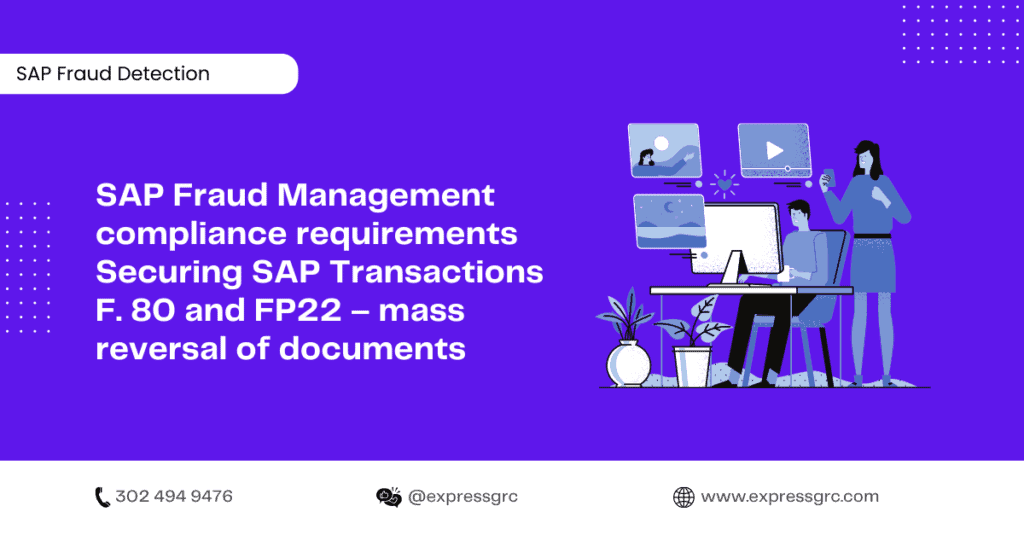Are you looking for effective ways to secure your SAP transactions and ensure compliance with SAP Fraud Management requirements? In this article, we will explore the importance of securing SAP transactions, specifically focusing on F.80 and FP22, and discuss how you can implement mass reversal of documents to enhance your organization’s fraud management capabilities.
Table of Contents
- Introduction
- Understanding SAP Fraud Management Compliance Requirements
- Securing SAP Transactions: F.80 and FP22
- Benefits of Mass Reversal of Documents
- Implementing Mass Reversal of Documents in SAP
- Best Practices for Securing SAP Transactions
- Conclusion
- FAQs
1. Introduction
In today’s digital landscape, businesses rely heavily on enterprise resource planning (ERP) systems like SAP to streamline their operations. However, with the increasing sophistication of cyber threats, it has become crucial for organizations to prioritize the security of their SAP transactions. One area that requires careful attention is the management of F.80 and FP22 transactions.
2. Understanding SAP Fraud Management Compliance Requirements
SAP Fraud Management is a comprehensive solution that helps organizations detect and prevent fraudulent activities within their SAP systems. To comply with SAP Fraud Management requirements, organizations need to ensure the security and integrity of their transactions, especially those involving F.80 and FP22.
F.80 transactions involve the mass reversal of documents, while FP22 transactions relate to the mass change of financial documents. These transactions can be particularly vulnerable to fraudulent activities if not properly secured.
3. Securing SAP Transactions: F.80 and FP22
To secure F.80 and FP22 transactions, organizations must implement robust security measures that prevent unauthorized access and ensure the integrity of the transaction data. Here are some key steps to consider:
H1: Implement Role-Based Access Controls
Role-based access controls (RBAC) limit system access to authorized users based on their specific roles and responsibilities within the organization. By assigning appropriate access rights and permissions, organizations can minimize the risk of unauthorized individuals performing F.80 and FP22 transactions.
H2: Enable Audit Logging and Monitoring
Enabling audit logging and monitoring features within SAP allows organizations to track and monitor all F.80 and FP22 transactions. By maintaining a comprehensive audit trail, organizations can quickly identify any suspicious activities and take immediate action to mitigate potential fraud risks.
H3: Regularly Review and Update User Permissions
Organizations should regularly review and update user permissions to ensure that only authorized individuals have access to F.80 and FP22 transactions. By conducting periodic reviews, organizations can identify and revoke unnecessary permissions, reducing the potential for fraudulent activities.
H3: Implement Two-Factor Authentication
Implementing two-factor authentication adds an extra layer of security to SAP transactions. By requiring users to provide two forms of identification, such as a password and a unique verification code, organizations can significantly reduce the risk of unauthorized access to F.80 and FP22 transactions.
4. Benefits of Mass Reversal of Documents
Implementing mass reversal of documents in SAP brings several benefits to organizations, including:
- Enhanced fraud detection: Mass reversal allows organizations to quickly identify suspicious transactions by reversing a large number of documents simultaneously. This capability enables timely detection and prevention of fraudulent activities.
- Improved efficiency: Mass reversal streamlines the process of correcting errors or invalid transactions, reducing the time and effort required to rectify discrepancies.
- Audit trail accuracy: By maintaining a comprehensive audit trail of reversed documents, organizations can ensure the accuracy and integrity of their financial records, simplifying compliance reporting.
5. Implementing Mass Reversal of Documents in SAP
To implement mass reversal of documents in SAP, organizations should follow these steps:
- Identify the target documents for reversal based on specific criteria, such as date range or document type.
- Execute the mass reversal program in SAP, specifying the relevant selection parameters.
- Review the reversal results and validate the changes made to ensure accuracy.
- Maintain a detailed log of the reversed documents for audit and compliance purposes.
6. Best Practices for Securing SAP Transactions
To ensure the security of SAP transactions and comply with SAP Fraud Management requirements, consider implementing the following best practices:
- Regularly update SAP systems with the latest security patches and fixes to address any vulnerabilities.
- Conduct thorough user training and awareness programs to educate employees about the importance of data security and fraud prevention.
- Implement encryption protocols to safeguard sensitive data transmitted during SAP transactions.
- Establish strong password policies and enforce regular password changes to prevent unauthorized access.
- Regularly monitor system logs and audit trails for any suspicious activities or anomalies.
- Conduct periodic vulnerability assessments and penetration testing to identify and address potential security weaknesses.
7. Conclusion
Securing SAP transactions, especially those involving F.80 and FP22, is crucial for organizations to protect their data, prevent fraud, and comply with SAP Fraud Management requirements. By implementing role-based access controls, enabling audit logging and monitoring, and following best practices for securing SAP transactions, organizations can enhance their fraud management capabilities and ensure the integrity of their financial records.
8. FAQs
Q1: What is SAP Fraud Management? SAP Fraud Management is a solution that helps organizations detect and prevent fraudulent activities within their SAP systems. It provides comprehensive tools and capabilities to enhance fraud management and compliance.
Q2: Why are F.80 and FP22 transactions vulnerable to fraud? F.80 transactions involve mass reversal of documents, and FP22 transactions relate to the mass change of financial documents. These transactions can be vulnerable if not properly secured, as they can be manipulated to conceal fraudulent activities.
Q3: How does mass reversal of documents help prevent fraud? Mass reversal allows organizations to quickly identify suspicious transactions by reversing a large number of documents simultaneously. This capability enables timely detection and prevention of fraudulent activities.
Q4: What are the benefits of implementing mass reversal of documents in SAP? Implementing mass reversal of documents improves fraud detection, enhances efficiency in error correction, and ensures audit trail accuracy in financial records.
Q5: What are the best practices for securing SAP transactions? Some best practices include regularly updating SAP systems, conducting user training and awareness programs, implementing encryption protocols, enforcing strong password policies, monitoring system logs, and conducting vulnerability assessments.

